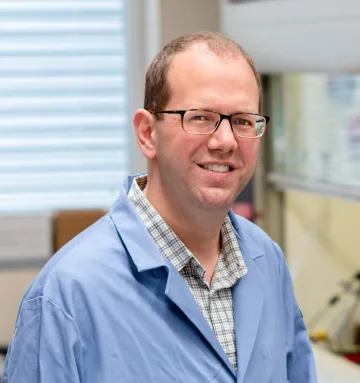When
Presenter:
Dr. Martin Schnermann
Senior Investigator, Chemical Biology Laboratory, National Cancer Institute
Abstract:
Recent progress in the translation of antibody-drug conjugates (ADCs) has validated the potential of ligand-targeted drug delivery strategies. However, the clinical application of these strategies has encountered significant, often unanticipated, toxicity. Critically, many of these toxicities do not result from monoclonal antibody (mAb) binding to its cognate target, but rather from deleterious effects of the hydrophobic small molecule/linker combination on in vivo targeting of the mAb. Novel experimental approaches are needed to assess targeting early in the design, synthesis, and testing process. We hypothesize that in vivo optical imaging is uniquely poised to assess the role of payloads and linkers on ADC properties. This is because optical probes are small molecules of similar molecular weight and physical properties to drug payloads.
We first set out to address the role of payload properties. By developing synthetic methods that enable the rapid synthesis of chemically varied heptamethine cyanines, we have assembled and quantitatively compared the targeting of a series of substituted variants. These efforts suggest that highly polar, and specifically zwitterionic, substituents dramatically improve the in vivo properties of mAb conjugates. To examine the role of ADC linkers, conventional always-ON probes are not suitable to study the site and extent of bond cleavage. To address this, we have created a new class of fluorogenic probes in the near-infrared (NIR) range that result from modification of heptamethine norcyanines with stimuli-responsive carbamate linkers. These norcyanine carbamates (CyBams) exhibit exceptional turn-ON ratios and can be activated by a range of enzymatic and chemical triggers. By optimizing the cellular uptake and retention of these probes, we have created mAb-targeted variants that allow us to quantitatively study linker chemistry in animal models. Overall, our goal is to develop an “imaging-first” workflow for the design and testing of well-tolerated targeted drug delivery agents.
Biosketch:

Dr. Schnermann attended Colby College and graduated in 2002 with degrees in Chemistry and Physics. At Colby, he worked with Prof. Dasan Thamattoor in the areas of physical organic chemistry and photochemistry. After a year at Pfizer Research and Development (Groton, CT) as an associate in the medicinal chemistry division, he moved to the Scripps Research Institute. During his graduate studies, he performed research on the total synthesis and biological evaluation of anticancer natural products with Prof. Dale Boger and obtained a Ph.D. in 2008. He then completed an NIH-postdoctoral fellowship with Prof. Larry Overman at the University of California, Irvine. At Irvine, he developed light-mediated reactions to enable the synthesis of complex natural products. In addition, working with Prof. Christine Suetterlin, he pursued chemical biology and imaging studies of organelle specific probes. In 2012, Dr. Schnermann joined the Chemical Biology Laboratory at the National Cancer Institute, where his research focuses on the synthesis and development of new small-molecule imaging agents for cancer treatment and diagnosis. In 2018, Dr. Schnermann was promoted to Senior Investigator.
Hosted By:
Dr. Michael Taylor






